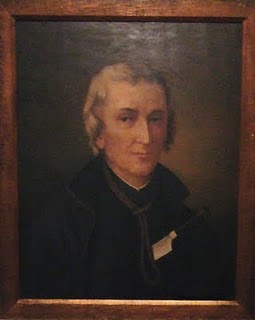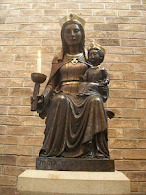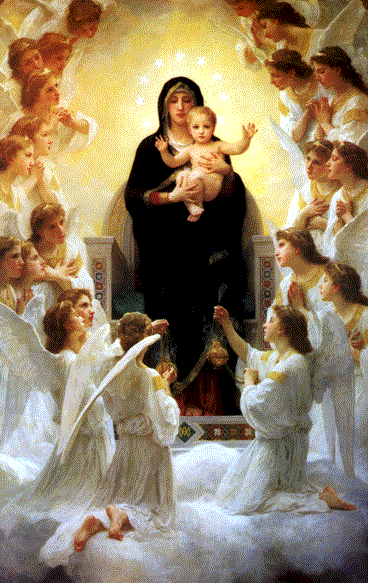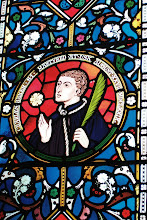2009 marks the 330th Anniversary of the martyrdom of four priests who were executed for “High Treason”. Philip Evans, John Lloyd, John Kemble and David Lewis were Catholic priests and to be a Catholic priest was considered treason. At the trial of Fr David Lewis, the judge, Sir Robert Atkins, made that abundantly clear when he said;
“It is enough that you have exercised the functions of a priest in copes and vestments used in your Church, and that you shall have read Mass and taken Confessions. He that uses to read Mass commits treason.”
Now, in the dying days of 2009, it is fitting to remember these four holy martyrs, two Jesuit priests and two secular priests.
FR JOHN KEMBLE
John Kemble, alias Holland, was born at Rhydicar Farm, St Weonards, Herefordshire in 1599. He was the son of John Kemble and Anne Morgan. He was ordained a priest at Douai on 23rd February 1625 and, on 4th June, was sent upon the English Mission. For 54 years Fr Kemble worked for the Catholics of Herefordshire and Monmouthshire. He was greatly loved by his own people and respected throughout the area because, it was said, he gave offence to none.
In 1678, Fr John Kemble became another innocent victim of the non-existent Popish Plot. A lapsed Catholic, Captain John Scudamore of Kentchurch, was sent to arrest Fr Kemble at Pembridge Castle, where the aged priest was staying with his relatives. When urged to flee, the 80 year old priest calmly said, “According to the course of nature I have but a few years to live. It will be an advantage to suffer for my religion and therefore I will not abscond.” After three months in Hereford Gaol, John Kemble endured an agonising journey to London where he and his kinsman, Fr David Lewis, were lodged in Newgate Prison. He was interrogated by Titus Oates and his fellow perjurers but, since no evidence of involvement in any plot could be found, Fr Kemble was sent back to Hereford Gaol. In accordance with Statute 27 of Elizabeth I, he was tried for treason, i.e. for being a Catholic priest and for saying Mass. He was found guilty, and condemned to be hanged, drawn and quartered.
to Hereford Gaol. In accordance with Statute 27 of Elizabeth I, he was tried for treason, i.e. for being a Catholic priest and for saying Mass. He was found guilty, and condemned to be hanged, drawn and quartered.
On 22nd August 1679, the morning of his execution, Fr Kemble made his devotions as usual. Before his execution on Widemarsh Common, the kindly old priest forgave all who had played a part in bringing him to such a situation and asked forgiveness of any whom he may have offended. Taking the hand of the distraught hangman, Fr Kemble said “Honest Anthony, my friend Anthony, be not afraid; do thy office. I forgive thee with all my heart. Thou wilt do me a greater kindness than discourtesy.” He prayed silently for a few minutes then commended himself to God. The cart was drawn away and he was hanged. Such was the affection for Fr Kemble that he was allowed to die upon the gallows before being beheaded. He was also spared the grisly ritual of drawing and quartering. It was said, even by his persecutors, that “they never saw one die so like a gentleman and so like a Christian”.
The martyr’s nephew, Captain Richard Kemble, took the body to the church at Welsh Newton and buried it beside the churchyard cross. The gravestone is inscribed “J K Dyed the 22 of August Anno Do 1679. Every year, on the Sunday nearest to 22nd August, there is a pilgrimage to the Saint’s grave.
FR DAVID LEWIS S J
David Lewis was born in Abergavenny in 1616 to Margaret Pritchard, a devout Catholic, and Morgan Lewis, who followed the Established Church. Morgan brought David up as a Protestant but, at about aged 19, David converted to Catholicism. Subsequently, he went to study in Rome where, in 1642, he was ordained as a Catholic priest. Three years later he became a Jesuit.
Fr David Lewis returned to his native Wales and, with the exception of a brief period in Rome, he spent his priestly life among the people of Monmouthshire and area. He was greatly loved and, for his kindness to all, he was known as “Tad y Tlodion”, “Father of the Poor”. Father Lewis, too, became a victim of the evil Titus Oate s. He was arrested at Llantarnam on Sunday 17th November 1678, as he prepared to celebrate Mass. He was brought for trial at the Lenten Assizes in Monmouth on 16th March 1679 and brought to the bar on a charge of High Treason, that is, for having become a Catholic priest and remaining in the country. He was found guilty of being a priest and the judge, Sir Robert Atkins, pronounced the usual sentence for treason – to be hanged, drawn and quartered.
s. He was arrested at Llantarnam on Sunday 17th November 1678, as he prepared to celebrate Mass. He was brought for trial at the Lenten Assizes in Monmouth on 16th March 1679 and brought to the bar on a charge of High Treason, that is, for having become a Catholic priest and remaining in the country. He was found guilty of being a priest and the judge, Sir Robert Atkins, pronounced the usual sentence for treason – to be hanged, drawn and quartered.
The condemned priest was brought to London with his cousin, Fr John Kemble, and questioned about the “Plot”. Titus Oates and his three henchmen, Bedloe, Dugdale and Price, questioned him about the “Plot” but they were unable to prove anything against him. Lord Shaftsbury offered him his life and rich rewards if he would give evidence about the “Plot” or renounce his Catholic Faith. The steadfast priest would do neither for as he declared in his dying discourse, “discover the plot I could not, as I knew of none; and conform I would not, for it was against my conscience”.
Fr David Lewis was brought back to Usk Gaol to await his execution. Fr Lewis was martyred at Usk on 27th August 1679. A Protestant man held his hand until he was dead, thereby preventing him being cut down and disembowelled while still alive. His body was permitted to be carried in procession to the churchyard of the Priory Church, Usk, and there it was buried. The Saint’s grave is the grave closest to the main door of the church. Annually, on the Sunday nearest to 27th August, there is a pilgrimage to this holy site.
In 1970, Pope Paul VI canonised the Forty Martyrs of England and Wales. Among them were the Welsh priests, St Philip Evans S J, St John Lloyd, St John Kemble and St David Lewis S J.
“It is enough that you have exercised the functions of a priest in copes and vestments used in your Church, and that you shall have read Mass and taken Confessions. He that uses to read Mass commits treason.”
Now, in the dying days of 2009, it is fitting to remember these four holy martyrs, two Jesuit priests and two secular priests.
FR JOHN KEMBLE
John Kemble, alias Holland, was born at Rhydicar Farm, St Weonards, Herefordshire in 1599. He was the son of John Kemble and Anne Morgan. He was ordained a priest at Douai on 23rd February 1625 and, on 4th June, was sent upon the English Mission. For 54 years Fr Kemble worked for the Catholics of Herefordshire and Monmouthshire. He was greatly loved by his own people and respected throughout the area because, it was said, he gave offence to none.
In 1678, Fr John Kemble became another innocent victim of the non-existent Popish Plot. A lapsed Catholic, Captain John Scudamore of Kentchurch, was sent to arrest Fr Kemble at Pembridge Castle, where the aged priest was staying with his relatives. When urged to flee, the 80 year old priest calmly said, “According to the course of nature I have but a few years to live. It will be an advantage to suffer for my religion and therefore I will not abscond.” After three months in Hereford Gaol, John Kemble endured an agonising journey to London where he and his kinsman, Fr David Lewis, were lodged in Newgate Prison. He was interrogated by Titus Oates and his fellow perjurers but, since no evidence of involvement in any plot could be found, Fr Kemble was sent back
 to Hereford Gaol. In accordance with Statute 27 of Elizabeth I, he was tried for treason, i.e. for being a Catholic priest and for saying Mass. He was found guilty, and condemned to be hanged, drawn and quartered.
to Hereford Gaol. In accordance with Statute 27 of Elizabeth I, he was tried for treason, i.e. for being a Catholic priest and for saying Mass. He was found guilty, and condemned to be hanged, drawn and quartered.On 22nd August 1679, the morning of his execution, Fr Kemble made his devotions as usual. Before his execution on Widemarsh Common, the kindly old priest forgave all who had played a part in bringing him to such a situation and asked forgiveness of any whom he may have offended. Taking the hand of the distraught hangman, Fr Kemble said “Honest Anthony, my friend Anthony, be not afraid; do thy office. I forgive thee with all my heart. Thou wilt do me a greater kindness than discourtesy.” He prayed silently for a few minutes then commended himself to God. The cart was drawn away and he was hanged. Such was the affection for Fr Kemble that he was allowed to die upon the gallows before being beheaded. He was also spared the grisly ritual of drawing and quartering. It was said, even by his persecutors, that “they never saw one die so like a gentleman and so like a Christian”.
The martyr’s nephew, Captain Richard Kemble, took the body to the church at Welsh Newton and buried it beside the churchyard cross. The gravestone is inscribed “J K Dyed the 22 of August Anno Do 1679. Every year, on the Sunday nearest to 22nd August, there is a pilgrimage to the Saint’s grave.
FR DAVID LEWIS S J
David Lewis was born in Abergavenny in 1616 to Margaret Pritchard, a devout Catholic, and Morgan Lewis, who followed the Established Church. Morgan brought David up as a Protestant but, at about aged 19, David converted to Catholicism. Subsequently, he went to study in Rome where, in 1642, he was ordained as a Catholic priest. Three years later he became a Jesuit.
Fr David Lewis returned to his native Wales and, with the exception of a brief period in Rome, he spent his priestly life among the people of Monmouthshire and area. He was greatly loved and, for his kindness to all, he was known as “Tad y Tlodion”, “Father of the Poor”. Father Lewis, too, became a victim of the evil Titus Oate
 s. He was arrested at Llantarnam on Sunday 17th November 1678, as he prepared to celebrate Mass. He was brought for trial at the Lenten Assizes in Monmouth on 16th March 1679 and brought to the bar on a charge of High Treason, that is, for having become a Catholic priest and remaining in the country. He was found guilty of being a priest and the judge, Sir Robert Atkins, pronounced the usual sentence for treason – to be hanged, drawn and quartered.
s. He was arrested at Llantarnam on Sunday 17th November 1678, as he prepared to celebrate Mass. He was brought for trial at the Lenten Assizes in Monmouth on 16th March 1679 and brought to the bar on a charge of High Treason, that is, for having become a Catholic priest and remaining in the country. He was found guilty of being a priest and the judge, Sir Robert Atkins, pronounced the usual sentence for treason – to be hanged, drawn and quartered.The condemned priest was brought to London with his cousin, Fr John Kemble, and questioned about the “Plot”. Titus Oates and his three henchmen, Bedloe, Dugdale and Price, questioned him about the “Plot” but they were unable to prove anything against him. Lord Shaftsbury offered him his life and rich rewards if he would give evidence about the “Plot” or renounce his Catholic Faith. The steadfast priest would do neither for as he declared in his dying discourse, “discover the plot I could not, as I knew of none; and conform I would not, for it was against my conscience”.
Fr David Lewis was brought back to Usk Gaol to await his execution. Fr Lewis was martyred at Usk on 27th August 1679. A Protestant man held his hand until he was dead, thereby preventing him being cut down and disembowelled while still alive. His body was permitted to be carried in procession to the churchyard of the Priory Church, Usk, and there it was buried. The Saint’s grave is the grave closest to the main door of the church. Annually, on the Sunday nearest to 27th August, there is a pilgrimage to this holy site.
In 1970, Pope Paul VI canonised the Forty Martyrs of England and Wales. Among them were the Welsh priests, St Philip Evans S J, St John Lloyd, St John Kemble and St David Lewis S J.
(The photo of St John Kemble is from a stained glass window at Harvington Hall and St David Lewis is from a stained glass window in the Catholic Church, Tenby.)








.JPG)

.JPG)



.JPG)

No comments:
Post a Comment